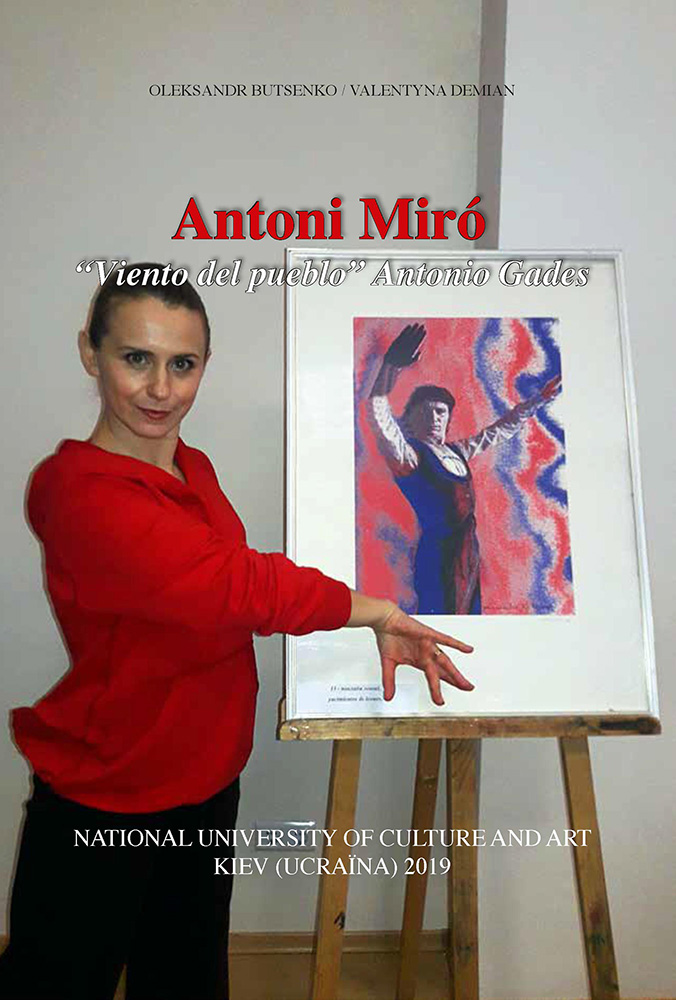Carried by wind of people
Olexander Butsenko
As musicologists have rightly emphasized, one of the most concentrated expression of synthetic nature inherent for the Spanish art is the style of cante flamenco1. It displays aspiration for freedom, ineradicable hope, powerful fortitude and dignity. One could call it a current of culture, a breath or a wind of people. It just is that has united three artists, originated from Valencian land in Spain, a poet Miguel Herna´ndez (1910-1942), a dancer Antonio Gades (1936-2004), and a painter Antoni Miro´ (b. 1944). “Wind of People” is the title of M. Herna´ndez book of poetry (1937) named after the same poem where the author sings for hope which doesn’t die, for freedom which each person deserves, and unswerving fortitude despite all evils and death.
24 lines of M. Herna´ndez poem gave names for 24 pieces of A. Miro´ graphic series “Wind of people” where the contemporary Catalan artist conveys by pictographic images the es- sence of flamenco and tells the life story of one of the most known Spanish dancers, Anto- nio Gades, from the beginning of his creative way (“Vientos del pueblo me llevan”) when Antonio Esteve Ro´denas, a teenager which should to work in odd jobs for supporting his family, started to attend a dance school, recruited in his 15 by Pilar Lopez, one of Spain’s great dancers, into her company, and on taking the stage name Gades became the world star of flamenco, to the last days of his life when struggling against the mortal illness he didn’t lost courage and resilience (ni quie´n al rayo // detuvo prisionero en una jaula ...).
A. Gades is a core personage of the series “Wind of people”. The plastic of fiery dance expressed in lines, colors and compositions by A. Miro´, discovers bright and dynamic images of M. Herna´ndez poem. On desiring convey the feeling of invincibility of his hero struggling against oppression, M. Herna´ndez has taken as examples such animals as lions, eagles and bull’s contrary to humble oxes. For aggrandizing these animals, A. Miro´ portrays moments when A. Gades is preparing to the performance, to the ritual of demon- stration on the stage his strength and esthetic of dance: “No soy de un pueblo de bueyes”. The synthesis of three languages – poetry, dance and painting, is notable especially in such works as “Los leones la levantan” where the dancer raises his hands preparing for the next step in the symbolic space: at the background of artist’s palette.
Gades’ face forms the basis of several works which identifies clearly the dancer with the hero of M. Herna´ndez poem devoted to ideals of freedom. It can be said that the “wind of people” enwraps the life of three Catalan artists creative works of which have merged into a single whole in the represented graphic series created by A. Miro´ talent, three artists de- voted earnestly to defense of the freedom, each of which has expressed his feelings with chosen artistic language and style, three artists carried by the “wind of people”.
Quoted from: Butsenko O. Synchronicity as the means of creative communication in the modern fine arts // Culture and Contemporaneity. Almanac – National Academy of Managerial Staff of Culture and Art – Kyiv, 2014. P.94-99 (in Ukrainian).
